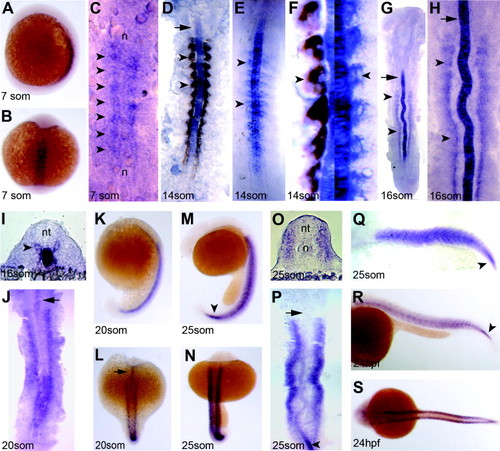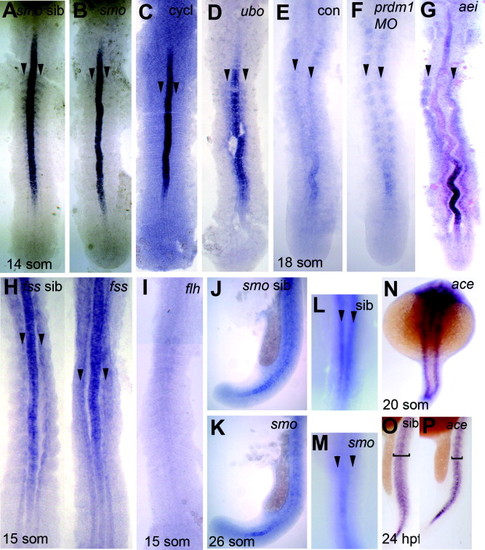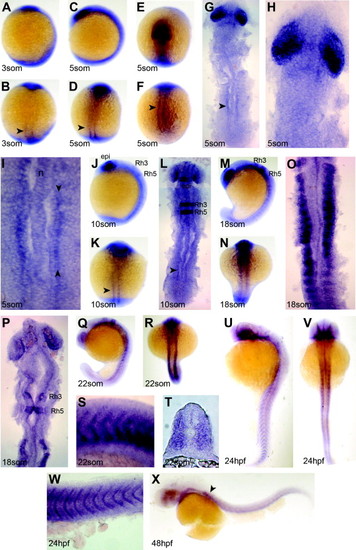- Title
-
Vestigial-like-2b (VITO-1b) and Tead-3a (Tef-5a) expression in zebrafish skeletal muscle, brain and notochord
- Authors
- Mann, C.J., Osborn, D.P., and Hughes, S.M.
- Source
- Full text @ Gene Expr. Patterns
|
Developmental expression of vgl-2b. In-situ mRNA hybridisation for vgl-2b (blue/purple) shown in lateral (A, E, K, M, Q, and R) or dorsal (B, F, L, N, and S) wholemount, dorsal flatmount (C, D, G, H, J, and P; anterior to top) and transverse cryosection (I and O; dorsal to top). (A–C) Expression of vgl-2b begins at low levels at ∼7s in adaxial cells (arrowheads) as they begin to differentiate, but is absent from notochord (n). (D–I) Vgl-2b mRNA co-localises with slow MyHC-antibody staining at 14 som (arrowheads, D–I). Shown in (F) are the co-expression of vgl-2b mRNA and MyHC around similar-shaped nuclei (arrowheads) in 3.5-fold magnifications of the boxed regions in (D) (at left) and (E) (at right, reversed). Notochord expression projects rostrally beyond the first somite (arrows in D, G, and H) and extends caudally adjacent to slow muscle. (J–L) At 20 som, signal diminishes in maturing notochord but persists in the most nascent posterior regions where somitogenesis is still occurring and adjacent to the hindbrain (arrows). (M–Q) Anterior notochord expression is lost by 25 som, but continues in the tail tip (arrowheads; M, P, Q, and R). Vgl-2b mRNA persists in muscle tissue, including fast muscle (O). (R and S) At 24 hpf, as somitogenesis concludes, vgl-2b expression in muscle declines. nt, neural tube; n, notochord. EXPRESSION / LABELING:
|
|
Hedgehog signalling is required for appropriate regulation of vgl-2b. In-situ mRNA hybridisation for vgl-2b (blue/purple) shown anterior to top in dorsal (A–I, L, and M) or lateral (J, and K) flatmount or dorsal (N) or lateral (O and P) wholemount. Arrowheads indicate lack of vgl-2b mRNA in adaxial cells. (A–C and J–M) Smoothened (siblings, A, J, L; smo, B, K, M) and cyclopamine-treated (cycl; C) embryos in which loss of hedgehog (Hh) signalling prevents adaxial slow myogenesis. Notochord expression is unaffected. (D–F) Neither prdm1 mutation (ubo, D) nor prdm1 morpholino injection (E and F) noticeably alters vgl-2b expression. (G and H) Mutations in deltaD (aei; G) or tbx24 (fss; H) affect somite borders, but vgl-2b expression persists in slow fibres (arrowheads), although poorly segmented. (I) Floatinghead (flh) mutants have an absence of notochord due to mutations in the homologue of Xenopus Xnot and lack both notochord and early adaxial expression of vgl-2b. (N–P) Fast fibres are reduced (brackets) at 24 hpf by loss of fgf8 in acerebellar (ace) mutants, but vgl-2b expression is otherwise present. EXPRESSION / LABELING:
PHENOTYPE:
|
|
Developmental expression of tead-3a. In-situ mRNA hybridisation for tead-3a in lateral (A, C, J, M, Q, U, and X) and dorsal (B, D, K, N, R, and V) views of wholemount (A–F, J, K, M, N, Q, R, U, V, and X), flatmount (G–I, L, O, P, S, and W) or cryosection (T, dorsal to top). (A–L) Somitic expression begins at 3 som in narrow adaxial bands (arrowheads) on either side of the notochord (n) that extend into the anterior presomitic mesoderm (I). Strong retinal expression is evident from 5 som, with epiphysis (epi) and rhombomeres (Rh) expression apparent by 10 som. (M–T) Adaxial expression persists until differentiation of fast muscle begins at 18 som, when signal is detected more broadly throughout the somite (T), but strongest in a posterior–ventral domain (S). Epiphysis and rhombomere expression declines. (U–X) By the end of somitogenesis, tead-3a mRNA is concentrated at the somite borders and in the branchial region. EXPRESSION / LABELING:
|
Reprinted from Gene expression patterns : GEP, 7(8), Mann, C.J., Osborn, D.P., and Hughes, S.M., Vestigial-like-2b (VITO-1b) and Tead-3a (Tef-5a) expression in zebrafish skeletal muscle, brain and notochord, 827-836, Copyright (2007) with permission from Elsevier. Full text @ Gene Expr. Patterns



